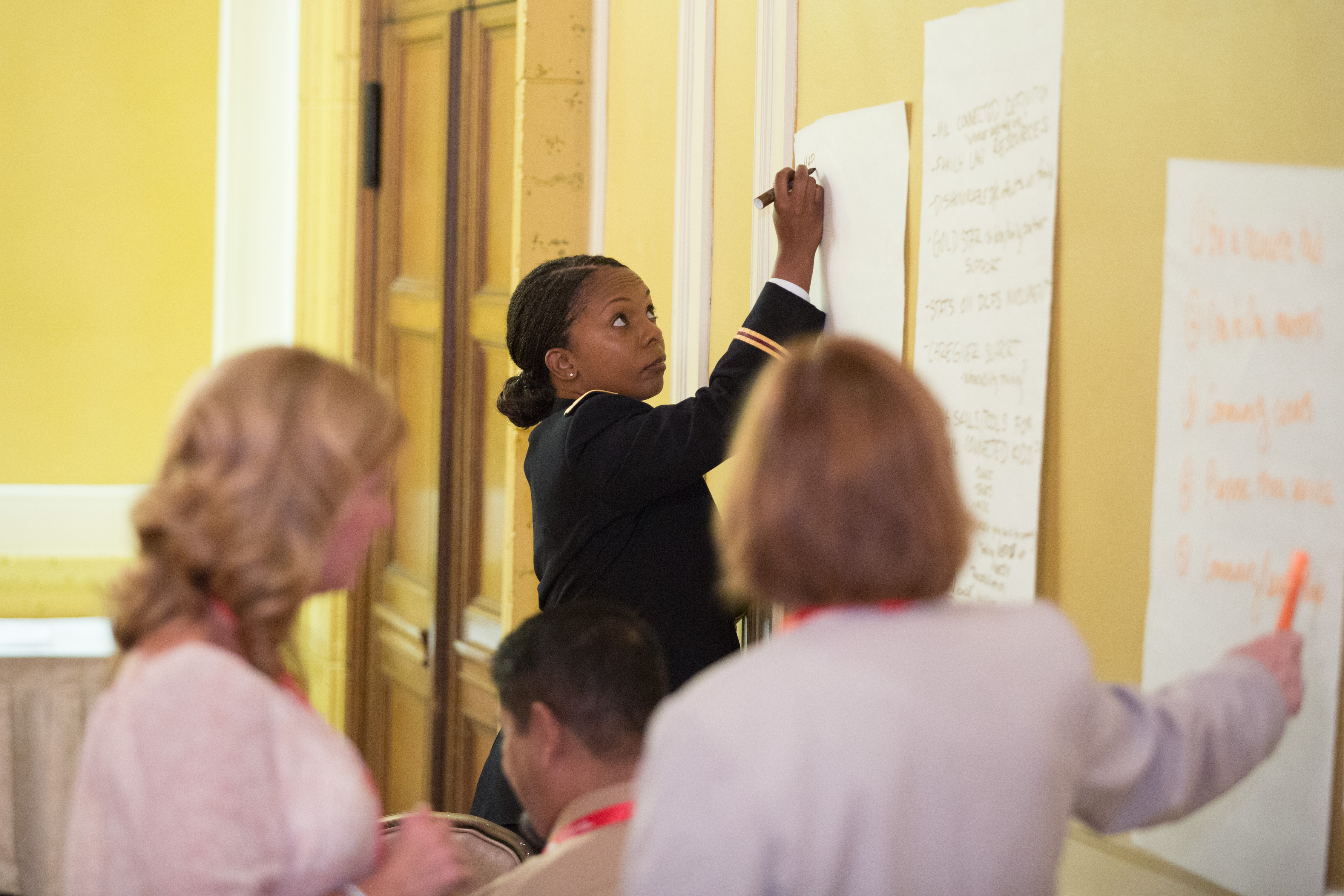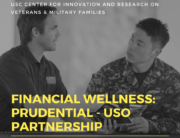The State of the American Veteran Conference, held Sept. 28-29 at the Millennium Biltmore Hotel, brought together more than 300 people to learn about the most pressing issues facing today’s military community and challenged them to devise recommendations that would address the biggest gaps and improve their well-being. Five conference tracks focused on different military populations, including combat veterans, student veterans, women veterans, Guard and Reserve service members, and children and families. Below are the recommendations from each track, along with discussion points where available.
For more information or questions about any of these, contact us at .
Combat recommendations were organized around five key challenges/barriers:
CHALLENGE #1: COMMUNITY INCLUSION
- Educate the community on military culture and military trauma.
- Educate the community on signs of suicide and resources.
Discussion:
- Connect with United Way’s Buddy Program, similar to a Big Brother/Big Sister, for veterans who have recently separated from service, or suggest community develop an “adopt a vet” program.
- Create more veteran business mixers. Suggest to veterans that they not ask for jobs, but rather ask for advice, build relationships and grow their network.
- Take advantage of free meeting spaces (e.g., public libraries, parks) that can provide venues for people to host programs in the community. Host events/programs with panels of veterans talking about their service.
- Encourage community to educate themselves and others about mental health issues. Work with the National Alliance on Mental Illness (NAMI) to help fight the stigma surrounding mental health.
- Work with media and lobby the entertainment studios about how they are portraying veterans. Request more public service announcements that address veterans’ needs.
CHALLENGE #2: TRANSITION
- Make transitional programs more robust and ensure they include life planning, financial literacy, transfer experience and leadership skills.
- Include families in the process.
Discussion:
- Encourage out-of-the-box thinking so no one falls between the cracks.
- Create larger system change.
- Allow six-month extension on active-duty orders to participate in an enhanced transition package and be assigned to a Reserve or Guard unit to help transition home.
- Shift the TAPS/TRS mission to the Reserve/Guard units so the unit could work with local VA to ensure enrollment into the VA health system, along with linkage with local services.
CHALLENGE #3: EXISTING SERVICES
- Consolidate services.
- Outreach efficiently.
- Provide feedback to improve programs.
Discussion:
- Ensure solid long-term funding streams and sustainable funding for nonprofits.
- Wrap-around services are important after veterans are employed and housed.
- Create and improve programs to increase success for veterans who receive services, while also reducing likelihood that they’ll be in need of similar services again in the future.
- Make service criteria more inclusive, which will allow veterans with non-honorable discharge statuses to access services.
- Focus on collective information sharing and be strategic with outreach
- SPA specific and how we address outreach, network with all providers in the area. Which requires a technological platform to collect this information.
- Outreach should be focused on a cultural competency approach.
- Provide feedback continually during the process versus at the end of a program.
CHALLENGE #4: STIGMA (in and out of service)
- Address employment discrimination.
- Encourage veterans to seek help when needed.
- Change public perception of veterans (e.g., not all homeless or drug addicts).
Discussion:
- Integrate communities and veteran groups.
- After service, there’s a continued sense of pride of service and it’s difficult to let go of that life. Veterans need to be able to deal/heal from military service.
- Commemorate the transition by having ceremonies when exiting service members complete service.
- Allow opportunities to celebrate veterans’ service. Provide outlets for veterans to share stories or gallery of military tattoos and the stories behind them.
- Continue to serve/volunteer in the community.
- Host entertainment events that are open to both veterans and community members so they can share their culture at the event (e.g., presentation of color guard, POW table)
- Allow veterans to celebrate veterans, the community and vice versa.
CHALLENGE #5: EMPLOYMENT
- Revamp the current transition training to bring it more up-to-date and applicable, and increase chances of employment from a wide variety of industries in the private sector.
-
- Provide training to help translate military skillsets to private sector job responsibilities. Educate both the veteran and employer of the earned skillsets that might not be readily apparent.
- Compile and disseminate lists of veteran-friendly businesses or recruiters.
- Encourage privatization of employment services for transitioning military, as private sector has more financial resources and would be more efficient; partner with companies like “LinkedIn” to leverage resources.
-
- To incentivize private sector and allow for sustainability (even when economy is down) to provide federal subsidies or tax credits to participating private companies
- Create an accreditation program for prior military service (e.g., a certificate or badge recognizable to employers and schools)
-
- Allows for acceptance of educational credits toward degree programs
- Recognized by private sector employers as credible prior work experience that can open applicant to more than just entry-level jobs when available.
- Create or identify more points of contact for transitioning service members after they leave the military (e.g., resource centers)
-
- Leverage the national community college network (1,400 schools) to host resource centers.
- While there are career centers for veterans at some colleges, this could create a standardization across the country.
- Federal funding will be needed to support these programs.
- Take advantage of innovative technologies, like artificial intelligence or “bots,” to automate information-gathering and make more accessible.
-
- We realize that the ideal would be to create “employment counselors,” like high school guidance counselors, as the needs of each transitioning military member is individual and unique; however, too much manpower would be required. AI would be the stop-gap. The information stored could also be kept or managed by a third-party not directly affiliated with the military so that transitioning military can privately and confidentially start exploring employment options and developing a transition plan without notifying the military in order to avoid negative repercussions that announcing leaving the military brings.
- Any policy considerations should keep in mind that that there are separate needs based on rank and military experience—there is no one-size-fits-all approach—in order to provide the best, most accurate, and widest net of services.
RECOMMENDATION #1:
Increase to recommended or mandated minimum-staffing levels for veteran services at institutions of higher learning (IHL), including certifying officials, professional staff, and leadership positions. The ratio should reflect staff to total veteran population, not merely those suing Chapter 33 benefits.
RECOMMENDATION #2:
Improve processes and policies for veterans regarding credit for prior learning at IHLs across the nation. Consider highlighting and funding the systems and/or states who are leading this effort to train those outside of their local areas.
RECOMMENDATION #3:
Develop collaborative work groups among key stakeholders (e.g., IHLs, licensing boards, Department of Defense, industry, etc.) around job sectors to align expedited pathways for job re-entry for veterans, especially those in career technical areas that require redundant training from that done in the military.
RECOMMENDATION #4:
Encourage both IHLs and the DOD to begin the transition process and the dialog about a future after military service earlier. It is recommended that we treat enlisted personnel similar to high school students in terms of planning and preparing for their next steps in career or education with at least two years notice. This would result in a smoother initial transition and a roadmap for success as a civilian but must be done locally on bases and coordinated with state entities.
ACTION ITEM #1:
As individuals, we are going to educate ourselves on the identity issues facing women veterans.
- Advocate for women veterans to be represented throughout our networks of influence as leaders.
ACTION ITEM #2:
As community leaders, we are going to advocate for women veterans.
- We are going to attend our neighborhood councils, schools and engage with employers to expand their knowledge.
- Create space in communities for women veterans to network and share resources.
ACTION ITEM #3:
As change agents, we are going to lead the charge.
- Share with government representatives the unique needs of women veterans and areas that need more funding.
- Add email to DD-214 form
- Childcare in VA
- Federal contracts to include military culture training
Discussion/Challenges:
At Individual Level:
Take ownership.
Use networks of influence (membership-rotary clubs, chamber of commerce, professional organizations).
Ask questions and be an advocate.
Collaborate with other veteran providers.
Put women veterans back into leadership roles and external-facing roles.
Create women veteran-specific programs. Link women veterans to resources.
Work with local community leaders to create task forces to fill gaps in services for women veterans.
Educate self and community.
Engage with women veterans.
Create a welcoming presence.
Stop being humble.
Empower.
Model behavior. Be the example.
Culture of competency and awareness.
Roles of women.
At Community and State Level:
Attend and facilitate a veteran-led community meeting.
Collaborate with other community partners to become knowledgeable about and measure the success of the plan.
Contact neighborhood councils and local libraries.
Make employers accountable to hire and retain women veterans.
Expand school curricula and staff it by competent women veterans.
Create women veteran-specific stop for resources.
Create an interactive electronic community one stop.
Network and locate veteran resources in your area.
Learn about the gaps in service and advocate at state level.
At Federal Level:
Pass legislation to allow childcare facilities in VA.
Support funding to expand women’s clinics in more VA and communities.
Attend roundtables for open sessions with congressional representatives/districts.
Vote on bills that affect women veterans, especially in terms of benefits and needs.
Sign petitions that advocate for change.
Include emails on DD-214 to improve outreach to veterans when they return home.
Provide free quality sanitary items for female veterans or monthly stipend.
Companies that get federal contracts should have a veteran specifically tasked with helping other veterans get ready for success and adapt to civilian culture.
Ensure preventative funding for women veterans.
Launch national campaigns and outreach efforts. Improve communication.
RECOMMENDATION #1:
Expand mental health and healthcare benefits to include Guard and Reserve service members.
- Free healthcare (under E5). Automatically enroll in TRICARE Reserve Select.
- Expand Health Care PPO to include Guard and Reserve service members.
RECOMMENDATION #2:
Fund battalion behavioral health officers and chaplains to deal with emergency relief, perform key trainings, host local behavioral providers/services, and promote resilience.
- Create a discretionary community fund (e.g., health, workshop, classes)
RECOMMENDATION #3:
Incentivize businesses to hire and retain Guard and Reserve service member employees.
- Contract with local temp agencies to provide discounted support
- Subsidize/tax benefits for placing Guard and Reservists
RECOMMENDATION #4:
Incentivize temporary work agencies to work with Guard and Reserve employees.
Provide employer support (temp)
RECOMMENDATION #5:
Create a public service announcement to market and promote benefits of hiring Guard and Reserve employees.
Incorporate (higher education) (competitive advantage)
RECOMMENDATION #6:
Support Guard and Reserve alumni events to build a community network and grow local services for the unit.
DEFINITION
There’s a need to establish a definition of “children and families.” What developed was the need to address the barriers for families due to criteria and definition.
- Military-connected families (term)
- All-inclusive
- Pre- and post-9/11 (no generation limitation)
- Whomever the military member or veteran deems as FAMILY
- Nuclear family
CHALLENGE #1: Access
- Lack of centralized knowledge for family resources (nationally & regionally). Consistent silos, barriers to systems access (VA & Private providers).
- Family camaraderie: Communication, engagement
- Outreach challenges
- Families being desensitized
- Navigating resources – need for resource mapping
CHALLENGE #2: Childcare
- Lack of affordable childcare while in service and as a transitioning family. Locations, safety, affordability. Limits dual incomes and financial security/stability for transition.
CHALLENGE #3: Transition Challenges
- Lack of training or access to training for families in transition
- Transition services start too late
CHALLENGE #4: Gap in Services
- Veteran spouse community underserved
- Lack of evidence-based focus (need) design or adopt a program
- Need family law model and services
- Caregiver support (training)
- Stigma non-combat injury caregiver
- Research (need more research to support needs assessments and programs)
- Lack of spirituality and faith-based interventions, support, education.
CHALLENGE #5: Mental Health and Well-Being
- Substance misuse/abuse
- Role between emotional/mental/physical needs and mission readiness
- Leadership support in addressing mental health challenges (early support versus after crisis occurs)
RECOMMENDATION #1: Prioritize access/availability/affordability of childcare.
- Support increase in affordable childcare and child care initiatives. Support legislation to address child care challenges (e.g., Sen. Gillibrand (NY) child care plan).
RECOMMENDATION #2: Outreach/awareness/education
- Increase transition training for families via teleconference. Holistic awareness workshops (virtual/in person/print)
- Educational, holistic, preventative peer support for families to obtain services through clinics.
- Office/NCO/SNCO trainings on how to build community, use resources, FROs, Community Orgs
- Coping skills/tools for military-connected kids
RECOMMENDATION #3: Renew Department of Defense policies and procedures regarding families
- Mission ready = family ready
- Begin transition education for families 36 months out
RECOMMENDATION #4: Project Renovation: (use of American Legions and Veterans of Foreign Wars)
- Use existing infrastructure
- System that already has a network & reach (VOICE!)
- Trust
- Involve families and spouses into the AL/VFW programs
- Mentorship opportunity
- Bring new partners to the table (Boys & Girls Club, Libraries, etc.)
- Generational support (bring back value of person-to-person support. Older generations)
- Be a resource hub
- One-to-one mentors
- Community leadership
- Community events
RECOMMENDATION #5: Create clinics for families
RECOMMENDATION #6: Empower “others” to work with veterans and families
- Build empathetic connection
- Mentorship/peer support
RECOMMENDATION #7: Be CLIENT-centered.
- Find out how best to serve clients.
- Design programs families need not what agency or organization “thinks” is good.
- Design systems of care around person in environment.








